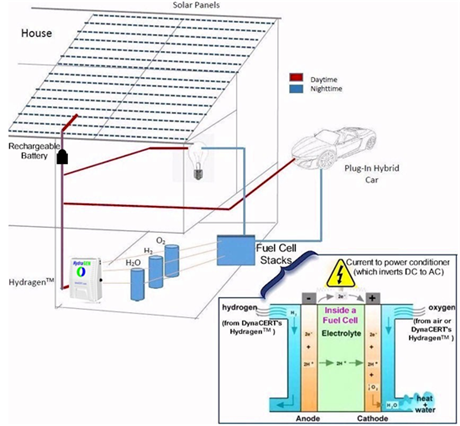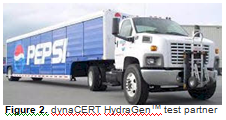dynaCERT Inc. Advancing Technology with Tesla-like Potential in Off-Grid Energy Solutions and Carbon Emission Reduction & Fuel-saving Technology
- dynaCERT's technology is capable of generating voluminous amounts of pure hydrogen and oxygen individually in a timed fashion.
- Technology proven to reduce toxic gasses within the emissions by 35% to 40% all while improving fuel economy of ~15%.
- Analyst Jay Taylor Provides 10X Share Price Target on High-Growth Technology Scenario.
dynaCERT Inc. (TSX-V: DYA) (OTC: DYFSF) is increasingly demonstrating Tesla-like potential as it advances its proprietary Hydragen
TM H2/O2 technology on two fronts, both with potential to change the world for the better, helping slow climate change, and handsomely reward shareholders. Currently trading near 9 cents Canadian per share DYA.V presents tremendous opportunity; analyst Jay Taylor of Hard Money Advisors maintains a ~$1.40/share near-term price target. Additionally, like Tesla, dynaCERT is advancing development and testing of its technology with grants from the government (translation: no shareholder dilution). dynaCERT's unique hydrogen production technology is ubiquitous in nature and can be applied to improving applications in numerous industries.
Currently the Company is documenting via an accredited 3rd-party validation process the dramatic effectiveness of its flagship carbon emission reduction and fuel-saving H2/O2 technology -- the potential for investors is tremendous as the solutions the Company provides are enormous and global in scale. An Ontario University facility has been engaged by dynaCERT in cooperation with the government to verify what the Company has already demonstrated on diesel engines in the field; a proven reduction of toxic gasses within the emissions by 35% to 40% all while improving fuel economy of ~15%. The lab is also tasked with helping to establishing the carbon-credits that businesses qualify for by purchasing and employing the technology.
On a newer second front, dynaCERT is targeting 'off-grid' energy solutions, leveraging its unique hydrogen production technology by marrying it with inputs from renewable energies (e.g. solar) to generate sufficient quantities of hydrogen to power fuel cell power stations. This program is currently in R&D with costs subsidized by grants which the Company is taking advantage of while the window of opportunity is open.
With the government now onboard to assign carbon credits for businesses to acquire dynaCERT's technology there is growing opinion that dynaCERT's potential economics are taking a dramatic leap, and investors acquiring shares now, prior to announcement catalysts, will reap significant returns. We expect many catalysts for the Company's share price as dynaCERT's state-of-the-art technology is first of its kind in several ways, including carbon credit recognition, and bound for high profile media coverage. Also it appears DYA.V shareholders are now getting a free-ride from the government, grant-wise, in the validation process.
dynaCERT's 'Off-Grid' Power Solutions Project
The following diagram shows an example of how dynaCERT's HydragenTM technology fits into the off-grid/cut-the-cord power system it is developing to provide renewable energy to the housing industry (also applicable to office spaces and industrial uses):
 Figure 1. (above) dynaCERT 'off-grid' power solution diagram with close-up view of how a fuel cell functions.
Figure 1. (above) dynaCERT 'off-grid' power solution diagram with close-up view of how a fuel cell functions. Solar panels and/or the hydrogen fuel cell will power the building by day using an energy optimization software. At night, the rechargeable batteries would then take over and activate the Hydragen™ unit which will keep the hydrogen fuel cell operating by providing the required hydrogen gas. The solar panels would also maintain the rechargeable batteries at full capacity until they are needed at night and the cycle repeats itself. Further, the pure oxygen which is also produced by the Hydragen™ unit would be used to improve the air quality in the building.
Fuel Cell 101
Fuel cells generate power by reacting hydrogen and oxygen in the presence of an electrolyte, a non-metallic conductor in which electrical flow is carried by the movement of ions, such as proton-exchange membrane cells. They function as follows:
- Hydrogen gas (produced by dynaCERT's HydragenTM) is delivered to a negatively charged anode on one side of the cell while oxygen is channeled to a positively charged cathode on the other side.
- At the anode, a catalyst (often involving platinum) knocks the hydrogen atoms’ electrons off, leaving positively charged hydrogen ions and free electrons.
- A membrane placed between the anode and cathode only allows the ions to pass through, and the electrons must travel along an external circuit – generating an electric current.
- At the cathode, the electrons and the hydrogen ions combine with oxygen to make water, which then flows out of the cell.
Cut-the-Cord Power Solutions -- an Industry that is Ripe for Rampant Growth and whose Time has Come
For the last couple decades players in fuel cell power generation sector have been involved in ongoing R&D focused on reducing cost and improving durability with the goal of eventually leading to mass commercialization/acceptance. Only a few years ago the industry experienced hydrogen fuel cell costs around $1,000 for every kilowatt of power they generated, now that cost is nearer $50 and expected to drop significantly further with technology in the pipeline (e.g. platinum-nickel alloys as catalysts (Lawrence Berkley Laboratories), and platinum with carbon silk (Ballard Power)). Fuel cell technology is now at a point where in the near future, fuel cells are expected to increasingly replace conventional furnaces and electrical power utility reliance, providing homes and offices with heat and electricity, free from the disruptions associated with the utility's electric grid. Technological improvements and economies of scale associated with rechargeable lithium-ion batteries and renewable energies (such as solar) have led to lower costs/increased affordability for those technologies too, and this trend is projected to increase also. In-short, the cut-the-cord type system that dynaCERT is advancing which entails a confluence of solar, rechargeable batteries, hydrogen fuel production, and fuel cells in an affordable, viable, coordinated fashion is a technology whose time is here.
DYA.V has the Product, Wherewithal, and the People to be a Leader in the Cut-the-Cord Power Generation Sector
• Central to the off-grid power system is dynaCERT's HydragenTM: dynaCERT is uniquely positioned with an established, proven, and reliable pure hydrogen and oxygen delivery product; its 3 L/minute Hydrogen unit currently in service (in the trucking industry) is able to generate voluminous amounts of pure hydrogen, and the technology is scalable, able to generate amounts for multiple larger scenarios. The Company's up-to-300 L/minute Hydrogen unit currently being used on a Wartsila engine at a utility in the Caribbean is testimony to the Company's ability to consistently, reliably, and safely deliver pure hydrogen on demand.
• Capitalized for success: The Company has stated it is the beneficiary of the push to see Canada reduce its carbon footprint; dynaCERT's May-2016 new release stated "It is an opportune time for dynaCERT to capitalize on this commitment to reduce carbon emissions and to access the Canadian and Ontario government grants and loans. As such, dynaCERT is positioning itself to become a world leader in research and development of hydrogen based technology solutions and receive available non-dilutive government funding."
• dynaCERT's off-grid power generation project is spearheaded by highly-skilled and accomplished individuals: Dr. Richard Lü, an independent director at dynaCERT, has more than 20 years of global experience in the energy industry. Dr. Lü has been involved in managing public listed companies in the area of silicon production, solar cell manufacturing and solar panel production. He has led many initiatives in energy conservation, demand response, distributed energy and other sustainable developments. Dr. Lü heads a major solar power company developing and operating solar PV projects in Canada and the USA. Dr. Lü is working alongside Dr. Richard Bower, a physicist and solar energy expert.
------ ------ ------ ------ ------ ------
dynaCERT's Targeting of the Carbon Economy
This Q1-2016 the Canadian-based technology company began shipping and installing the first of its new-generation proprietary HydragenTM carbon emission reduction and fuel-saving units for the trucking industry; DYA.V is currently filling an initial orders, is building an inventory, and is undergoing a build-out in a new 8,000 square foot facility that will position itself to be able to manufacture at a rate of 2000/month (in an 8 hour shift). Over the last few years DYA.V has worked with some of the largest trucking fleets in the world under the understanding that with 3rd-party validation of a minimum 8% fuel savings they will commence outfitting their fleet with dynaCERT's 'HydraGenTM' units. There has been no disagreement that DYA.V's technology accomplished 8%+ fuel-savings, the issue since has been obtaining the hard data to give to engineers of its clientele; it has been a time consuming and expensive process -- the recent involvement of the provincial and federal government in providing carbon credit and efficacy takes dynaCERT to an heightened level of potential. All of the data is objectively computer generated, pulled right from the trucks and sent to an accredited 3rd-party source.

Note: When accreditation is received, and dynaCERT puts out its first 10,000 units, its sales at that point are expected to generate ~US$67,500,000 and the company is basically working on 60% gross margin profit.
Additional related insight on the dynaCERT Inc. and it’s technology may be viewed at https://technologymarketwatch.com/dya.htm online.
James O’Rourke
James is a freelance information services professional for various media relation firms and consultant to several publicly traded entities. He monitors and invests in the resource, technology, consumer staples, healthcare, agriculture, financial, energy, utilities, and biotechnology/pharmaceutical sectors and is the managing director of TechnologyMarketWatch.comt. His articles have been published on over 400 websites, including:
Yahoo Finance, Market Intelligence Center, MarketWatch, WallStreetJournal, USAToday, FinancialPost, BayStreet, Financial Content, Ibtimes, Oil&GasJournal, Moneytalks, SeekingAlpha.
***
Legal Notice / Disclaimer
This document is not and should not be construed as an offer to sell or the solicitation of an offer to purchase or subscribe for any investment.
James O’Rourke has based this document on information obtained from sources he believes to be reliable but which has not been independently verified.
James O’Rourke makes no guarantee, representation or warranty and accepts no responsibility or liability as to its accuracy or completeness. Expressions of opinion are those of James O’Rourke only and are subject to change without notice. James O’Rourke assumes no warranty, liability or guarantee for the current relevance, correctness or completeness of any information provided within this Report and will not be held liable for the consequence of reliance upon any opinion or statement contained herein or any omission.
Furthermore, I, James O’Rourke, assume no liability for any direct or indirect loss or damage or, in particular, for lost profit, which you may incur as a result of the use and existence of the information provided within this Report.
James does not currently own shares of dynaCERT Inc. TSX.V – DYA however intends to accumulate, and supporters of DYA are a sponsor of his related site technologymarketwatch.com.